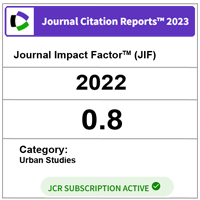Impact of Street’s Physical Elements on Walkability: a Case of Mawlawi Street in Sulaymaniyah, Iraq
DOI:
https://doi.org/10.11113/ijbes.v3.n1.106Abstract
A pleasant walking environment is a precondition for living in a sustainable city. Appropriate street design can increase quality and quantity of walking. However, the adequacy and quality of physical elements as the most significant components of street can seriously affect walkability in the streets. The objective of this study was to critically assess the walkability level in terms of physical elements of Mawlawi Street, a famous commercial street located in the city center of Sulaymaniyah, Iraq. The qualitative research based on interview with locals, direct observation and quantitative research via questionnaire with pedestrians were conducted in this study. First, site observation was carried out through PEDS (Pedestrian Environment Data Scan) audit tool and the taking of photographs in order to observe the streetscape features. In this regard, four criteria as environment, pedestrian facility, road attributes, walking environment, and subjective assessment were considered as well serving the purpose of providing a broad direction about streetscape features. Then, a 5 point Likert scale questionnaire with pedestrians was conducted to triangulate the findings from observation. Later on, the findings were validated through an interview with locals regarding their subjective ideas about those criteria. The study showed that inadequate and poor quality of street’s physical elements changed the street to an unsafe and uncomfortable environment for walking with weak and low level of street connectivity and accessibility for pedestrians.
References
Azmi, D.I., & Karim, H.A. (2012). Implications of walkability towards promoting sustainable urban neighbourhood. Procedia-Social and Behavioral Sciences, 50, 204-213.
Brown, B.B., Werner, C.M., Amburgey, J.W., & Szalay, C. (2007). Walkable route perceptions and physical features converging evidence for en route walking experiences. Environment and behavior, 39(1), 34-61.
Brownson, R.C., Hoehner, C.M., Day, K., Forsyth, A., & Sallis, J.F. (2009). Measuring the built environment for physical activity: State of the science. American journal of preventive medicine, 36(4), S99-S123. e112.
Clifton, K.J., Livi Smith, A.D., & Rodriguez, D. (2007). The development and testing of an audit for the pedestrian environment. Landscape and Urban Planning, 80(1), 95-110.
Daisa, J.M. (2010). Designing walkable urban thoroughfares: A context sensitive approach: Institute of Transportation Engineers.
Ferguson, E., & Cox, T. (1993). Exploratory factor analysis: A users’ guide. International Journal of Selection and Assessment, 1(2), 84-94.
Forsyth, A., Hearst, M., Oakes, J.M., & Schmitz, K.H. (2008). Design and destinations: Factors influencing walking and total physical activity. Urban Studies, 45(9), 1973-1996.
Frank, L., Engelke, P., & Schmid, T. (2003). Health and community design: The impact of the built environment on physical activity: Island Press.
Fruin, J.J. (1971). Pedestrian planning and design.
Gehl, J. (2010). Cities for people: Island Press.
Giles-Corti, B., Kelty, S.F., Zubrick, S.R., & Villanueva, K.P. (2009). Encouraging walking for transport and physical activity in children and adolescents. Sports medicine, 39(12), 995-1009.
Handy, S.L., Boarnet, M.G., Ewing, R., & Killingsworth, R.E. (2002). How the built environment affects physical activity: Views from urban planning. American journal of preventive medicine, 23(2), 64-73.
Jackson, G. (2009). Denver’s first pedestrian priority zone. doi: http://www.ppta.net/todtoolkit/assets/downloads/TODLibrary_Multi-Modal_SmartTranspo_General_Downtown_Denver.pdf
Jacobs, A.B. (1993). Making great streets. Great Streets, 269-292.
Jacobs, J. (1961). The death and life of great American cities: Random House LLC.
Kostof, S. (1992). The city assembled: London.
LaPlante, J., & McCann, B. (2008). Complete streets: We can get there from here. ITE journal, 78(5), 24.
Leow, Y.C. (2008). Enhancing the pedestrian experience in Singapore: A closer look at MRT transfers and CBD walkability. Massachusetts Institute of Technology.
Litman, T.A. (2003). Economic value of walkability. Transportation Research Record: Journal of the Transportation Research Board, 1828(1), 3-11.
Lo, R.H. (2009). Walkability: What is it? Journal of Urbanism, 2(2), 145-166.
McNally, K. (2010). Design guidelines for walkable communities. Ohio, United State: Niehoff Studio.
Moughtin, C. (2003). Urban design: Street and square: Routledge.
Mousavi, S.M., & Khan, T.H. (2013). Adding affordability to sustainability: A study of environmentally sustainable design elements in housing in Malaysia. Germany: LAP (Lambert Academic Publishing).
Mousavi, S.M., Khan, T.H., & Javidi, B. (2013). Environmentally sustainable affordable design elements in housing in the context of Malaysia: Focus on middle income group. Life Science Journal, 10(3).
Nakazawa, A. (2011). Walkability of three downtown Vancouver streets: Evaluating the physical and perceptual qualities of the built environment.
Powell, K.E., Martin, L.M., & Chowdhury, P.P. (2003). Places to walk: Convenience and regular physical activity. American journal of public health, 93(9), 1519-1521.
Rykwert, J. (1986). The street: The use of its history. On streets, 14-27.
Saelens, B.E., & Handy, S.L. (2008). Built environment correlates of walking: A review. Medicine and science in sports and exercise, 40(7 Suppl), S550.
Southworth, M. (2005). Designing the walkable city. Journal of urban planning and development, 131(4), 246-257.
Southworth, M., & Ben-Joseph, E. (2003). Streets and the shaping of towns and cities: Island Press.
Taha, H. (2007). Urban growth in the city of Sulaymaniyah. (Master), University of Koya, Koya, Iraq.
Wall, E., & Waterman, T. (2010). Basics landscape architecture 01: Urban design (Vol. 1): AVA Publishing.
Wey, W.-M., & Chiu, Y.-H. (2013). Assessing the walkability of pedestrian environment under the transit-oriented development. Habitat International, 38, 106-118.
Whyte, W.H. (2012). City: Rediscovering the center: University of Pennsylvania Press.
Downloads
Published
How to Cite
Issue
Section
License
Copyright of articles that appear in International Journal of Built Environment and Sustainability belongs exclusively to Penerbit Universiti Teknologi Malaysia (Penerbit UTM Press). This copyright covers the rights to reproduce the article, including reprints, electronic reproductions or any other reproductions of similar nature.
Authors who publish with this journal agree to the following terms:
- This Journal applies Creative Commons Licenses of CC-BY-NC-SA
- Authors retain copyright and grant the journal right of publication with the work simultaneously licensed under a Creative Commons Attribution License that allows others to share the work with an acknowledgement of the work's authorship and publication in this journal.
- Authors are able to enter into separate, additional contractual arrangements for the non-exclusive distribution of the journal's published version of the work (e.g., post it to an institutional repository or publish it in a book), with an acknowledgement of its publication in this journal.
- Authors are permitted and encouraged to post their work online (e.g., in institutional repositories or on their website) prior to and during the submission process, as it can lead to productive exchanges, as well as earlier and greater citation of published work (See The Effect of Open Access).







